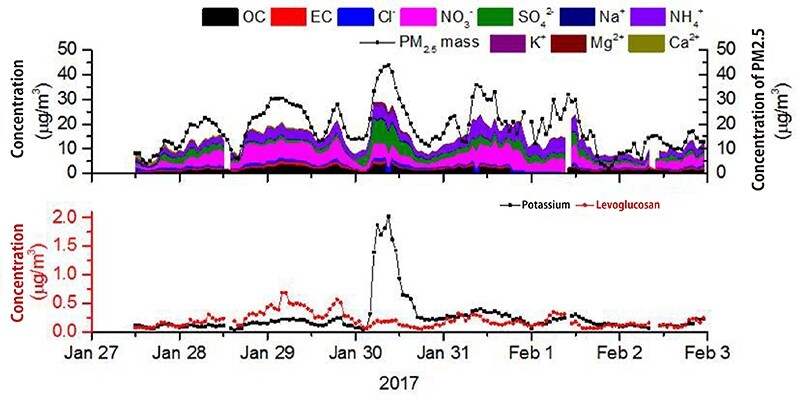hankyoreh
Links to other country sites 다른 나라 사이트 링크
Scientists prove that particulate matter from China leads to high concentration of fine dust over Korean Peninsula

It was scientifically demonstrated for the first time that some of the particulate matter in the air above the Korean Peninsula, often called “fine dust,” originated in China. “We have succeeded at demonstrating scientifically the fact that pollutants from China have entered South Korea and raised the particulate matter density to a severe level,” the Korea Research Institute of Standards and Science (KRISS) said on Mar. 20.

After analyzing the chemical composition of fine dust on the Korean Peninsula during the Lunar New Year in 2017 (from Jan. 27 to Feb. 2), a research team led by Jung Jin-sang, head of research at KRISS’s Center for Gas Analysis, announced that the fine dust was caused by the large number of fireworks set off during the Lunar New Year. While satellite imagery had already confirmed that high concentrations of fine dust in South Korea were caused by the influx of fine dust from China, this was the first this had been demonstrated scientifically.
Fine dust, which refers to particulate matter 2.5 (PM2.5), is typically released during the combustion of fossil fuels or biomass (such as crops and forests). But since the two countries have similar manufacturing and agricultural sectors, it was difficult to determine the source of the fine dust through analyzing its chemical composition.
The research team solved this conundrum by developing a system for real-time measurement of potassium and levoglucosan, which are materials that constitute fine dust. Potassium is emitted during the combustion of both firecrackers and biomass, but levoglucosan is only emitted when biomass is burned.

“If the concentration of potassium sharply increases and the concentration of levoglucosan does not change, it is possible to conclude that the fine dust was created when firecrackers went off,” the research team said. Over the Lunar New Year last year, potassium levels in the South Korean atmosphere jumped more than sevenfold, while levoglucosan levels remained constant.
In related news, South Korea’s Ministry of Environment announced that as of Mar. 27, it would be bringing its environmental standards for fine dust in line with those in the US and Japan. This will mean stricter standards, lowering the current levels from a daily average concentration of 50㎍/㎥ and a yearly average concentration of 25㎍/㎥ to a daily average of 35㎍/㎥ and a yearly average of 15㎍/㎥. While the new standards are still looser than those recommended by the World Health Organization, they are identical to those used in the US and Japan.
By Lee Keun-young and Kim Jung-su, senior staff writers
Please direct questions or comments to [english@hani.co.kr]

Editorial・opinion
![[Column] Season 2 of special prosecutor probe may be coming to Korea soon [Column] Season 2 of special prosecutor probe may be coming to Korea soon](https://flexible.img.hani.co.kr/flexible/normal/500/300/imgdb/original/2024/0426/3317141030699447.jpg) [Column] Season 2 of special prosecutor probe may be coming to Korea soon
[Column] Season 2 of special prosecutor probe may be coming to Korea soon![[Column] Park Geun-hye déjà vu in Yoon Suk-yeol [Column] Park Geun-hye déjà vu in Yoon Suk-yeol](https://flexible.img.hani.co.kr/flexible/normal/500/300/imgdb/original/2024/0424/651713945113788.jpg) [Column] Park Geun-hye déjà vu in Yoon Suk-yeol
[Column] Park Geun-hye déjà vu in Yoon Suk-yeol- [Editorial] New weight of N. Korea’s nuclear threats makes dialogue all the more urgent
- [Guest essay] The real reason Korea’s new right wants to dub Rhee a founding father
- [Column] ‘Choson’: Is it time we start referring to N. Korea in its own terms?
- [Editorial] Japan’s rewriting of history with Korea has gone too far
- [Column] The president’s questionable capacity for dialogue
- [Column] Are chaebol firms just pizza pies for families to divvy up as they please?
- [Column] Has Korea, too, crossed the Rubicon on China?
- [Correspondent’s column] In Japan’s alliance with US, echoes of its past alliances with UK
Most viewed articles
- 1[Column] Season 2 of special prosecutor probe may be coming to Korea soon
- 2‘We must say no’: Seoul defense chief on Korean, USFK involvement in hypothetical Taiwan crisis
- 3Is N. Korea threatening to test nukes in response to possible new US-led sanctions body?
- 4No good, very bad game for Korea puts it out of Olympics for first time since 1988
- 5Is Japan about to snatch control of Line messenger from Korea’s Naver?
- 6Division commander ordered troops to enter raging flood waters before Marine died, survivor says
- 7Korea’s 1.3% growth in Q1 signals ‘textbook’ return to growth, says government
- 8N. Korean delegation’s trip to Iran shows how Pyongyang is leveraging ties with Moscow
- 9[Editorial] Korea’s surprise Q1 growth requires objective assessment, not blind fanfare
- 10[Editorial] Government needs to stop impeding Sewol mourning